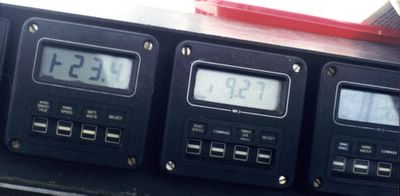August 11, 1998 Dash to Samoa
 9.27 knots
9.27 knotsThere was this guy at the bar at the Sloop Tavern in Seattle with long hair and leathery, sunburned skin, looking generally scruffy and disreputable, but he had a friendly, easy demeanor, and he was entertaining the regulars with his stories from the South Pacific. He said for the last ten years he’d been living on his boat in Pago Pago, only it was pronounced Pango Pango, and he was soon to go back there. To a land bound sailor like me, stuck in Seattle, with dreams of the South Pacific already filling my head, it struck a note. I didn’t have any idea where exactly in the South Pacific Pago Pago was, but I was surely going to go there. Maybe I’d hang out there for 10 years too.
So we left Bora Bora with three other boats on that windy day in early August, 1998, and set sail for Pago Pago, in American Samoa. The others were heading to Nuie or Tonga, or some other atoll somewhere, and they diverged on courses more southerly than ours. Few boats had much interest in American Samoa with it’s reputation of being the armpit of the Pacific, trashy, smelly, and unfriendly, but it was supposed to be a good stop for provisioning. And that guy in the Sloop Tavern made it sound romantic.
The trades were still active, still reinforced, and the other boats quickly reefed down, but we were flying, and I didn’t see any point in slowing down. With a full main and poled out number four we rocked on and powered our way westward, consistently seeing 8’s and 9’s on the dial. We talked on the radio to Isis and the others and they were incredulous that we hadn’t reduced sail.
But this passage was going to be a speed run if I had my way. We’d been in lighter air most of the way across the Pacific, and we were behind schedule. Now that we had the wind, I wanted to get some big numbers in the log book, and we did. On this passage we logged 201 miles noon to noon on one day, and had a couple of days over 195, but it wasn’t fun. On Wings speeds over nine knots are hard to get, hull speed firmly limits us to the mid eights, but with big waves and strong winds, if you push it, you can surf ahead into those nines and even sometimes touch 10 knots. Between the waves you’re going to drop to the mid sevens. To get the average up you have to hold the pedal to the metal. The loads on the boat, however, get dangerously high. The sheets and guys are bar tight, the mast creaks and groans, and the wind vane is making sounds that no one likes to hear, straining and creaking as it tries to horse this big rolling and swerving machine back onto some semblance of a straight line.
 Windvane having a workout
Windvane having a workoutThen there is the water rushing by. At nine knots it is the roar of a mountain waterfall, and the waves around your stern sound like they have boulders in them. In the kind of winds it takes to push this boat at those speeds you get noise in the rig too, a howling moan that reminds you of demons from hell. At night it is all worse, you can’t see a thing, but to get 200 miles in this boat, you have to keep going all night too. On my night watches I sat there in the dark looking at yellow glow of the speedometer, watching the numbers clock up in synch with the sounds of the water as it increased it’s roar on those big surfs. It was mesmerizing, but I couldn’t relax, I could only hang on and wait, fully alert, for something to go wrong.
On some boats the sound down below is worse than on deck, as the hulls seem to amplify every noise, but on Wings, particularly downwind, sometimes it seems almost calm down below, even as the scene on deck borders on chaos. You lie on the leeward sea berth and look up through the hatch at your partner standing watch there, and it seems serene, peaceful. It is easy to get hopeful, from that soft, warm, off-watch nest, that the wind is down, that the speeds are off a bit. You ask the watch stander, “Is the wind down?” and it is a shock when the answer comes back, “No, it’s still over 35 most of the time.” As an afterthought, they add, “But we seem to be doing OK in it.”
If it’s Judy down below, she’ll then ask, “Should we reef?” and I’ll say something sharp, like, “Reef, why reef? We’re doing fine.”
As much as I like the speeds, I do feel the stress, but for Judy I know it is worse. While I watch the speedometer, looking for the big numbers, she is watching the true windspeed, dreading the big numbers there. We know each other well enough so I know how she feels and what she is going to say, just as she knows my answer. But if I have my mind made up, if I say the decision is to carry on, she keeps her peace and doesn’t complain; until the next watch, when she wakes up hopeful again of a drop in the wind, and we go through the same ritual.
Well, nothing bad happened on this trip, and on the afternoon of the sixth day we arrived at Teama Bank, off the entrance to Pago Pago Harbor. We’d averaged 180 nautical miles per day since leaving Bora Bora
Fred & Judy, SV Wings, Pago Pago
Labels: sailing

.jpg)

0 Comments:
Post a Comment
<< Home